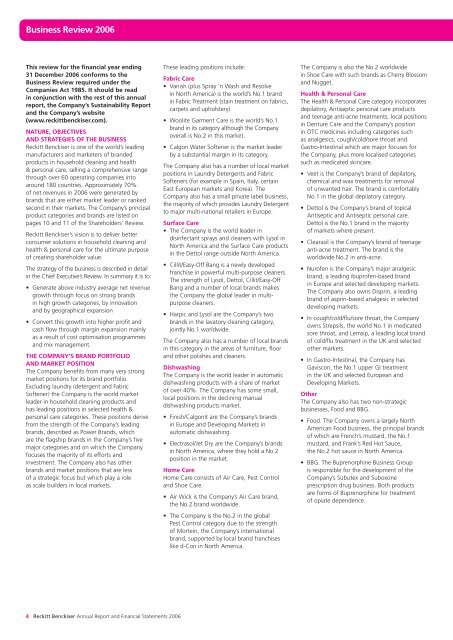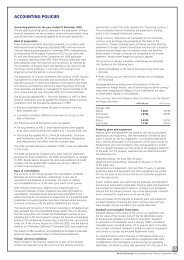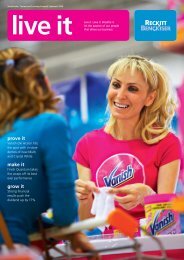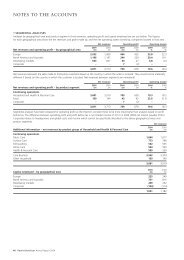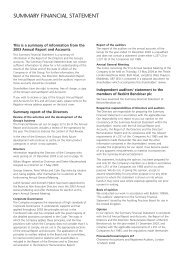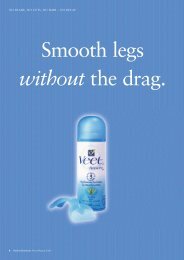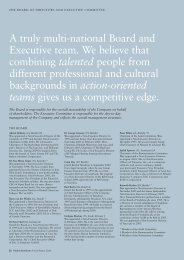Business Review 2006 - Reckitt Benckiser
Business Review 2006 - Reckitt Benckiser
Business Review 2006 - Reckitt Benckiser
You also want an ePaper? Increase the reach of your titles
YUMPU automatically turns print PDFs into web optimized ePapers that Google loves.
<strong>Business</strong> <strong>Review</strong> <strong>2006</strong><br />
This review for the financial year ending<br />
31 December <strong>2006</strong> conforms to the<br />
<strong>Business</strong> <strong>Review</strong> required under the<br />
Companies Act 1985. It should be read<br />
in conjunction with the rest of this annual<br />
report, the Company’s Sustainability Report<br />
and the Company’s website<br />
(www.reckittbenckiser.com).<br />
NATURE, OBJECTIVES<br />
AND STRATEGIES OF THE BUSINESS<br />
<strong>Reckitt</strong> <strong>Benckiser</strong> is one of the world’s leading<br />
manufacturers and marketers of branded<br />
products in household cleaning and health<br />
& personal care, selling a comprehensive range<br />
through over 60 operating companies into<br />
around 180 countries. Approximately 70%<br />
of net revenues in <strong>2006</strong> were generated by<br />
brands that are either market leader or ranked<br />
second in their markets. The Company’s principal<br />
product categories and brands are listed on<br />
pages 10 and 11 of the Shareholders’ <strong>Review</strong>.<br />
<strong>Reckitt</strong> <strong>Benckiser</strong>’s vision is to deliver better<br />
consumer solutions in household cleaning and<br />
health & personal care for the ultimate purpose<br />
of creating shareholder value.<br />
The strategy of the business is described in detail<br />
in the Chief Executive’s <strong>Review</strong>. In summary it is to:<br />
• Generate above industry average net revenue<br />
growth through focus on strong brands<br />
in high growth categories, by innovation<br />
and by geographical expansion<br />
• Convert this growth into higher profit and<br />
cash flow through margin expansion mainly<br />
as a result of cost optimisation programmes<br />
and mix management.<br />
THE COMPANY’S BRAND PORTFOLIO<br />
AND MARKET POSITION<br />
The Company benefits from many very strong<br />
market positions for its brand portfolio.<br />
Excluding laundry (detergent and Fabric<br />
Softener) the Company is the world market<br />
leader in household cleaning products and<br />
has leading positions in selected health &<br />
personal care categories. These positions derive<br />
from the strength of the Company’s leading<br />
brands, described as Power Brands, which<br />
are the flagship brands in the Company’s five<br />
major categories and on which the Company<br />
focuses the majority of its efforts and<br />
investment. The Company also has other<br />
brands and market positions that are less<br />
of a strategic focus but which play a role<br />
as scale builders in local markets.<br />
These leading positions include:<br />
Fabric Care<br />
• Vanish (plus Spray ’n Wash and Resolve<br />
in North America) is the world’s No.1 brand<br />
in Fabric Treatment (stain treatment on fabrics,<br />
carpets and upholstery).<br />
• Woolite Garment Care is the world’s No.1<br />
brand in its category although the Company<br />
overall is No.2 in this market.<br />
• Calgon Water Softener is the market leader<br />
by a substantial margin in its category.<br />
The Company also has a number of local market<br />
positions in Laundry Detergents and Fabric<br />
Softeners (for example in Spain, Italy, certain<br />
East European markets and Korea). The<br />
Company also has a small private label business,<br />
the majority of which provides Laundry Detergent<br />
to major multi-national retailers in Europe.<br />
Surface Care<br />
• The Company is the world leader in<br />
disinfectant sprays and cleaners with Lysol in<br />
North America and the Surface Care products<br />
in the Dettol range outside North America.<br />
• Cillit/Easy-Off Bang is a newly developed<br />
franchise in powerful multi-purpose cleaners.<br />
The strength of Lysol, Dettol, Cillit/Easy-Off<br />
Bang and a number of local brands makes<br />
the Company the global leader in multipurpose<br />
cleaners.<br />
• Harpic and Lysol are the Company’s two<br />
brands in the lavatory cleaning category,<br />
jointly No.1 worldwide.<br />
The Company also has a number of local brands<br />
in this category in the areas of furniture, floor<br />
and other polishes and cleaners.<br />
Dishwashing<br />
The Company is the world leader in automatic<br />
dishwashing products with a share of market<br />
of over 40%. The Company has some small,<br />
local positions in the declining manual<br />
dishwashing products market.<br />
• Finish/Calgonit are the Company’s brands<br />
in Europe and Developing Markets in<br />
automatic dishwashing.<br />
• Electrasol/Jet Dry are the Company’s brands<br />
in North America, where they hold a No.2<br />
position in the market.<br />
Home Care<br />
Home Care consists of Air Care, Pest Control<br />
and Shoe Care.<br />
• Air Wick is the Company’s Air Care brand,<br />
the No.2 brand worldwide.<br />
• The Company is the No.2 in the global<br />
Pest Control category due to the strength<br />
of Mortein, the Company’s international<br />
brand, supported by local brand franchises<br />
like d-Con in North America.<br />
The Company is also the No.2 worldwide<br />
in Shoe Care with such brands as Cherry Blossom<br />
and Nugget.<br />
Health & Personal Care<br />
The Health & Personal Care category incorporates<br />
depilatory, Antiseptic personal care products<br />
and teenage anti-acne treatments, local positions<br />
in Denture Care and the Company’s position<br />
in OTC medicines including categories such<br />
as analgesics, cough/cold/sore throat and<br />
Gastro-Intestinal which are major focuses for<br />
the Company, plus more localised categories<br />
such as medicated skincare.<br />
• Veet is the Company’s brand of depilatory,<br />
chemical and wax treatments for removal<br />
of unwanted hair. The brand is comfortably<br />
No.1 in the global depilatory category.<br />
• Dettol is the Company’s brand of topical<br />
Antiseptic and Antiseptic personal care.<br />
Dettol is the No.1 brand in the majority<br />
of markets where present.<br />
• Clearasil is the Company’s brand of teenage<br />
anti-acne treatment. The brand is the<br />
worldwide No.2 in anti-acne.<br />
• Nurofen is the Company’s major analgesic<br />
brand, a leading ibuprofen-based brand<br />
in Europe and selected developing markets.<br />
The Company also owns Disprin, a leading<br />
brand of asprin-based analgesic in selected<br />
developing markets.<br />
• In cough/cold/flu/sore throat, the Company<br />
owns Strepsils, the world No.1 in medicated<br />
sore throat, and Lemsip, a leading local brand<br />
of cold/flu treatment in the UK and selected<br />
other markets.<br />
• In Gastro-Intestinal, the Company has<br />
Gaviscon, the No.1 upper GI treatment<br />
in the UK and selected European and<br />
Developing Markets.<br />
Other<br />
The Company also has two non-strategic<br />
businesses, Food and BBG.<br />
• Food. The Company owns a largely North<br />
American Food business, the principal brands<br />
of which are French’s mustard, the No.1<br />
mustard, and Frank’s Red Hot Sauce,<br />
the No.2 hot sauce in North America.<br />
• BBG. The Buprenorphine <strong>Business</strong> Group<br />
is responsible for the development of the<br />
Company’s Subutex and Suboxone<br />
prescription drug business. Both products<br />
are forms of Buprenorphine for treatment<br />
of opiate dependence.<br />
4 <strong>Reckitt</strong> <strong>Benckiser</strong> Annual Report and Financial Statements <strong>2006</strong>
THE INDUSTRY, MARKET AND<br />
COMPETITIVE ENVIRONMENT<br />
The household cleaning and health & personal<br />
care industry is characterised by steady growth<br />
in demand with little variation due to macroeconomic<br />
factors, particularly in developed<br />
markets. Some developing markets exhibit more<br />
volatile demand in reaction to macro-economic<br />
factors. The principal drivers of market growth<br />
in all markets are the rate of household<br />
formation and growth in the level of disposable<br />
income, combined with demand for new<br />
products that offer improved performance<br />
or greater convenience.<br />
The industry is intensely competitive, with<br />
a comparatively small number of major multinational<br />
competitors accounting for a large<br />
proportion of total global demand. The Company<br />
competes with numerous, well-established,<br />
local, regional, national and international<br />
companies, some of which are very large and<br />
aggressively establish and defend their products,<br />
market shares and brands. Principal competitors<br />
include FMCG companies like Procter & Gamble,<br />
Colgate Palmolive, Clorox, S.C. Johnson, Henkel,<br />
Unilever, and such pharmaceutical companies as<br />
GlaxoSmithKline, Johnson & Johnson, Novartis<br />
and Bayer, plus a number of strong local<br />
industry players.<br />
The Company competes, particularly in strongly<br />
branded segments, through its focus on its<br />
leading position in higher growth categories<br />
where it is typically the market leader or a close<br />
follower, its ability to introduce new products<br />
(whether improved or newly developed)<br />
supported by a rising and substantial level<br />
of marketing, particularly media, investment.<br />
Much industry competition focuses on<br />
competing claims for product performance<br />
rather than price or terms. For this reason, failure<br />
to introduce new products and gain acceptance<br />
thereof may significantly impact the Company’s<br />
operating results. The Company also encounters<br />
challenges to its leadership positions in markets,<br />
the defence against which requires significant<br />
marketing expenditure and promotional activity.<br />
The Company’s products also compete for<br />
consumers with private label products sold<br />
by major retail companies. Private label<br />
penetration has continued to grow globally<br />
in recent years. The Company competes with<br />
private label primarily by focusing on delivering<br />
innovative new products with real consumer<br />
benefits, which private label typically does<br />
not focus on, and by consistent marketing<br />
investment to communicate the benefits of<br />
its brands direct to consumers, where private<br />
label is not advertised.<br />
Technological change and product improvement<br />
can therefore be a key determinant of the<br />
Company’s success. <strong>Reckitt</strong> <strong>Benckiser</strong>’s success<br />
in introducing new and improved products<br />
stems from its heavy focus on developing<br />
a pipeline of product innovation. The Company<br />
maintains a large category development<br />
organisation, including market and consumer<br />
research, R&D and marketing/sales best practice,<br />
to fuel this pipeline and share category success<br />
factors and learning. The Company invests over<br />
£84m a year in R&D. While the Company<br />
believes R&D to be a key contributor to<br />
innovative new products, it does not believe<br />
it to be the dominant performance indicator<br />
for innovation success. The Company’s success<br />
is demonstrated by the fact that almost 40%<br />
of its net revenues come from products launched<br />
over the last three years.<br />
INTERNATIONAL OPERATIONS<br />
AND REGULATORY POSITION<br />
The household and health & personal care<br />
industry is heavily regulated by, inter alia, the<br />
European Union, the United States government<br />
and individual country governments elsewhere.<br />
Ingredients, manufacturing standards, labour<br />
standards, product safety, marketing and<br />
advertising claims are all subject to detailed<br />
and developing regulation.<br />
<strong>Reckitt</strong> <strong>Benckiser</strong> has operating companies<br />
in some 60 countries and has sales in up<br />
to 180 countries worldwide. At present,<br />
over 75% of the Company’s net revenues derive<br />
from Europe, North America and Australia/New<br />
Zealand with the remainder coming from mostly<br />
semi-established or developing economies.<br />
The Company is expanding its operations<br />
in these semi-established and developing<br />
economies, which may bring increased risks<br />
from greater economic volatility, additional<br />
governmental burden and regulation,<br />
political instability, and local labour conditions.<br />
However this is not the case with all developing<br />
markets many of which offer higher economic<br />
growth potential.<br />
The Company structures its business through<br />
a matrix of a centralised Category Development<br />
organisation, Global Sales organisation, Supply<br />
organisation and support functions (finance,<br />
human resources, information services)<br />
combined with three Area organisations,<br />
Europe, North America & Australia,<br />
and Developing Markets.<br />
The central Category Development function,<br />
where appropriate supported by Global Sales,<br />
is responsible for Power Brand strategies,<br />
brand equity programmes and best practices,<br />
new product development, including R&D,<br />
consumer and market research, for<br />
implementation by the Area organisation.<br />
The geographical structure is in three Areas that<br />
are responsible for local execution of marketing<br />
and sales programmes:<br />
• Europe. The Area covers the regions<br />
of Northern Europe (UK, Ireland, Scandinavia),<br />
Central Europe (Germany, Netherlands,<br />
Austria, Switzerland), Western Europe<br />
(France, Belgium), Southern Europe (Italy,<br />
Greece), South Western Europe (Spain,<br />
Portugal and export business) and Eastern<br />
Europe (Poland, Hungary, Czech<br />
Republic/Slovakia/Romania, Adriatics,<br />
Russia/CIS, Turkey).<br />
• North America & Australia. The Area covers<br />
the markets of North America (USA, Canada)<br />
and Australia and New Zealand.<br />
• Developing Markets covers the regions<br />
of Latin America (Brazil, Mexico, Argentina<br />
and smaller markets), Africa Middle East<br />
(South Africa, Middle East, Pakistan, East<br />
Africa, West Africa), South Asia (India,<br />
Bangladesh, Sri Lanka, Indonesia) and East<br />
Asia (Korea, Hong Kong/China/Taiwan,<br />
Singapore/Malaysia, Thailand, Japan).<br />
The Supply function is responsible for all<br />
procurement (raw and packaging materials and<br />
services), production and logistics globally, and<br />
is directly responsible for the operation of the<br />
Company’s 43 production facilities worldwide.<br />
Approximately 80% of manufacturing<br />
and supply is through these 43 sites around<br />
the world, with facilities located in Europe<br />
(17 facilities), North America (6 facilities),<br />
Australia New Zealand (1 facility) and the<br />
remaining facilities spread across Asia (10),<br />
Latin America (4) and Africa Middle East (5).<br />
These include a small number of facilities<br />
in higher risk labour and social environments<br />
in Asia and Latin America.<br />
Information Services is responsible for the<br />
Company’s global systems infrastructure<br />
and global systems, including the Company’s<br />
chosen Enterprise Resource Planning (ERP)<br />
system and its associated programmes.<br />
The Company has a comprehensive set of<br />
policies and procedures designed to enforce<br />
and protect its reputation and govern its<br />
business methods and practices. These cover,<br />
inter alia, a comprehensive Code of <strong>Business</strong><br />
Conduct, an Environmental Policy, a Global<br />
Manufacturing Standard, and a policy on<br />
product safety. Internal controls on issues<br />
of environmental, social, governance and<br />
reputational risk are further outlined on<br />
page 14 of this report.<br />
<strong>Reckitt</strong> <strong>Benckiser</strong> Annual Report and Financial Statements <strong>2006</strong> 5
<strong>Business</strong> <strong>Review</strong> <strong>2006</strong><br />
continued<br />
RESOURCES<br />
The major resources required by the business<br />
are an adequate supply of the raw and<br />
packaging materials consumed by the<br />
Company’s products, and the necessary funds<br />
for developing new products and reinvestment<br />
in advertising and promoting those brands.<br />
The other principal resource is management.<br />
The Company considers that its primary raw<br />
materials, such as bulk chemicals including<br />
a number of petrochemicals, plastics, pulp,<br />
metal cans etc. are in more than adequate<br />
supply globally. The costs of these items<br />
fluctuate from time to time but not at levels<br />
that seriously impinge on the ability of the<br />
Company to supply its products or generate<br />
margin. The Company is profitable, and cash<br />
generative, even after reinvesting in marketing,<br />
specifically media, at levels well above the<br />
industry average. The Company therefore<br />
believes that its ability to reinvest in supporting<br />
and building its brands is a significant<br />
competitive advantage.<br />
Supply constraints do exist in the Company’s<br />
supply chain from time to time. These normally<br />
arise due to unexpected demand for new<br />
products or to the time delay involved in<br />
stepping up production of new items to<br />
the levels required to supply many millions<br />
of units internationally.<br />
The Company’s supply chain is deliberately<br />
relatively well spread in terms of geography<br />
and technology such that the reliance on any<br />
one facility is minimised. However there are<br />
a number of facilities that remain critical to<br />
the Company’s supply chain, particularly those at<br />
Ladenburg (Germany), Nowy Dwor (Poland) and<br />
Sao Paolo (Brazil), and where major interruption<br />
to normal working could involve disruption to<br />
supply. The Company’s suppliers are similarly<br />
deliberately well spread in terms of geography<br />
and supplied items but there are nonetheless<br />
some risks to continuity of supply arising from<br />
some specialised suppliers both of raw materials<br />
and of third party manufactured items.<br />
The supply of strong management for the<br />
Company remains more than adequate. This<br />
is attributable to the Company’s culture and<br />
to its highly performance-oriented remuneration<br />
system which is based on paying for excellent<br />
performance. The Company believes that its<br />
ability to attract and retain the excellent<br />
management it needs to continue its success<br />
depends critically on this system.<br />
The Company trains and develops its<br />
management pipeline, through formal training<br />
programmes, and through a deliberate policy of<br />
training on the job. The Company has 12 formal<br />
training modules for middle management and<br />
Top 400 managers. During <strong>2006</strong> the Company<br />
ran 52 courses on these modules, training over<br />
900 people. Management is international, and<br />
is trained through rotation in international<br />
postings both in countries and in the Company’s<br />
central functions. Succession planning is a<br />
critical management discipline and is reviewed<br />
at least annually at the full Board and the<br />
Executive Committee.<br />
The Company closely monitors and tracks<br />
its Top 400 international managers (T400), the<br />
core management team of the business. This is<br />
a diverse group, consisting of 53 nationalities,<br />
and over half of the T400 group is working<br />
in a country that is not their original domicile,<br />
consistent with the Company’s policy to develop<br />
a multi-national management team. Turnover<br />
within this T400 group in <strong>2006</strong> was 9.2% which<br />
the Company considers satisfactory given the<br />
need to retain high-quality management offset<br />
by the benefits of refreshing the team with new<br />
talent. <strong>2006</strong> saw a relatively high rate of activity<br />
in terms of promotions, moves and recruitment<br />
to the T400 group due to the integration of BHI<br />
and associated reorganisation. As a result, the<br />
levels of promotions, moves within the T400<br />
and new recruitment ran at levels higher than<br />
in recent years (around 40 of each). However<br />
the Company ended the year with a historically<br />
low level of vacancies within the T400 group<br />
– between 15 and 20, or less than 5% of the<br />
measured group.<br />
There is a comprehensive set of policies<br />
governing employment and employees to<br />
ensure that the Company remains an attractive<br />
employer. The Group is committed to the<br />
principle of equal opportunity in employment;<br />
no applicant or employee receives less<br />
favourable treatment on the grounds of<br />
nationality, age, gender, religion or disability.<br />
It is essential to the continued improvement in<br />
efficiency and productivity that each employee<br />
understands the Company’s strategies, policies<br />
and procedures. Open and regular communication<br />
with employees at all levels is an essential part<br />
of the management process. A continuing<br />
programme of training and development<br />
reinforces the Company’s commitment to<br />
employee involvement. The Board encourages<br />
employees to become shareholders and to<br />
participate in the Company’s employee share<br />
ownership schemes.<br />
The Company relies on its brand names and<br />
intellectual property. All of the Company’s<br />
brand names are protected by nationally<br />
or internationally registered trademarks.<br />
The Company also maintains patents or other<br />
protection for its significant product formulation<br />
and processing methods. The Company<br />
aggressively monitors these protections<br />
and pursues any apparent infringements.<br />
RELATIONSHIPS AND PRINCIPAL RISKS<br />
The Company’s critical external relationships<br />
are with its major customers, typically the large<br />
grocery, mass market, multiple retailers, and its<br />
suppliers of raw and packaging materials and<br />
finished goods.<br />
The Company’s customer base is diffuse with no<br />
single customer accounting for more than 10%<br />
of net revenues, and the top 10 customers only<br />
accounting for between a quarter and a third<br />
of total net revenues. These customers are<br />
becoming more concentrated and more multinational,<br />
increasing demands on the Company’s<br />
service levels. In addition, many retailers<br />
compete with the Company’s products with<br />
their own private label offerings. The Company<br />
maintains its relationship with its principal retail<br />
customers through the efforts of its dedicated<br />
sales force, including key account directors,<br />
and its global sales organisation specifically<br />
set up to manage its interface with the growth<br />
of international retailers.<br />
The Company has many suppliers. The suppliers<br />
are predominantly international chemical and<br />
packaging companies. The Company sources<br />
most of its supplies through its global<br />
purchasing function, which acts as its primary<br />
interface with its suppliers.<br />
The principal risk factors that may be considered<br />
in relation to the Company are, in the opinion<br />
of the Directors:<br />
Market risks<br />
• Demand for the Company’s products may<br />
be adversely affected by changes in consumer<br />
preferences<br />
• Customers, mainly large retailers, may decide<br />
to de-list the Company’s brands, or not<br />
participate in the active promotion of the<br />
brands through in-store programmes<br />
• Competition may reduce the Company’s<br />
market shares and margins<br />
• The expiry of the Company’s exclusive licence<br />
for Suboxone in the United States in 2009<br />
with the possibility that the Company will not<br />
develop new forms that offer new intellectual<br />
protection beyond 2009 (see additional<br />
disclosures below)<br />
• Competition from private label and unbranded<br />
products may intensify. Specifically, generic<br />
competition may erode Subutex’s business<br />
in Europe.<br />
Operational risks<br />
• The Company’s new product pipeline may<br />
not generate consumer-relevant innovation<br />
and improvement to fuel growth and build<br />
market shares<br />
• Key management may leave or management<br />
turnover may significantly increase<br />
• Information technology systems may be<br />
disrupted or may fail, despite the Company’s<br />
disaster recovery processes, interfering with<br />
the Company’s ability to conduct its business<br />
• Regulatory decisions and changes in the legal<br />
and regulatory environment could increase<br />
costs or liabilities or limit business activities<br />
6 <strong>Reckitt</strong> <strong>Benckiser</strong> Annual Report and Financial Statements <strong>2006</strong>
• Operating results may be affected by<br />
increased costs or shortages of raw materials,<br />
labour or by disruption to production facilities<br />
or operating centres<br />
• Unfavourable economic or business conditions<br />
may adversely affect or disrupt operations<br />
in countries in which the Company operates<br />
• The Company may not be able to protect<br />
its intellectual property rights.<br />
Environmental, social and governance risks<br />
Another group of risks concern the reputation<br />
of the Company and its brands, but are reduced<br />
by the fact that the Company and its brands<br />
are not necessarily connected in the mind<br />
of consumers.<br />
Risks from the perspective of Environmental,<br />
social and governance (ESG) are discussed in<br />
the Report of the Directors on pages 14-15.<br />
These should be read in conjunction with the<br />
Company’s Sustainability Report (available<br />
on the Company’s website) which addresses<br />
the Company’s exposures to a number<br />
of reputation-affecting issues and how<br />
the Company is addressing such risks,<br />
and which is independently verified.<br />
In summary, the principal ESG risks identified<br />
by the Company are:<br />
• Industry Sector/Product & Consumer Safety<br />
Risks. The Household products and Health<br />
& Personal Care sectors have a number of<br />
product and ingredient issues relating to<br />
concerns voiced over the long-term effects<br />
of household chemicals and OTC drug<br />
ingredients on human health and the<br />
environment<br />
• Supply Chain Risks. Most product and raw<br />
material supply chains present a number of<br />
potential reputational risks relating to: labour<br />
standards; health, safety and environmental<br />
standards; raw material sourcing; and the<br />
social, ethical and environmental performance<br />
of third party manufacturers and suppliers<br />
• Product Quality & Safety Risks. Failures in<br />
product quality controls could potentially<br />
lead to damage to the reputation of and<br />
trust in the Company’s brands.<br />
The Company has a full set of policies, building<br />
on its central Code of <strong>Business</strong> Conduct, that<br />
address all aspects of the Company’s ESG<br />
behaviour. The Code itself is the subject of an<br />
annual review and certification process. The<br />
Board holds an annual review of ESG issues.<br />
Financial risks<br />
The Company’s policies and procedures on the<br />
management of financial risk are explained in<br />
detail below. The Company has a number of risk<br />
exposures in relation to tax, treasury, financial<br />
controls and reporting that are actively managed<br />
through the Company’s financial manual of<br />
policies and procedures, through regular reviews<br />
and controls, and through regular auditing,<br />
both internal and external.<br />
Additional information on BBG<br />
A small but rapidly growing part of <strong>Reckitt</strong><br />
<strong>Benckiser</strong>’s healthcare business is the<br />
prescription business of BBG which principally<br />
markets two products: Subutex and Suboxone.<br />
Both products are forms of Buprenorphine for<br />
treatment of opiate dependence. Suboxone is<br />
a more advanced form compared to Subutex,<br />
as it has substantially better protection against<br />
abuse by the opioid-dependent population.<br />
Subutex is principally marketed in Europe by<br />
Schering Plough Corporation Kenilworth, New<br />
Jersey to whom it is licensed, while Suboxone<br />
is sold by <strong>Reckitt</strong> <strong>Benckiser</strong> directly in the USA<br />
and Australia. Suboxone has recently received<br />
marketing approval from the European<br />
Commission for treatment in the 25 states<br />
of the European Union, Norway and Iceland.<br />
Since 2002, the BBG business has grown from<br />
a very small proportion to represent 3% of<br />
the total Company net revenues and a higher<br />
proportion of operating profits.<br />
Net revenues for BBG were as follows:<br />
2004 % change 2005 % change <strong>2006</strong> % change<br />
£m @ const FX £m @ const FX £m @ const FX<br />
89 +32% 121 +35% 156 +30%<br />
As with all prescription drugs, the intellectual<br />
property protection of this business has a finite<br />
term unless replaced with new treatments<br />
or forms. Therefore, the revenue and income<br />
of this business may not be sustained going<br />
forward unless replaced with new treatments<br />
or forms on which the Company is actively<br />
working. <strong>Reckitt</strong> <strong>Benckiser</strong> has market exclusivity<br />
for Suboxone in the United States, until the<br />
end of 2009. The recent approval for Suboxone<br />
in Europe will result in a ten-year market<br />
exclusivity. At the same time, the Company<br />
is engaged in developing potential new<br />
treatments with third parties that would have<br />
either patent protection or market exclusivity<br />
in similar areas to where it is active today.<br />
PERFORMANCE OF THE BUSINESS IN <strong>2006</strong><br />
Net revenues grew by 18% (18% constant)<br />
to £4,922m. The underlying business grew by<br />
6% (7% constant) to £4,428m. BHI contributed<br />
net revenues of £494m for the 11 months<br />
of ownership.<br />
Adjusted operating profit increased 26%<br />
(27% constant) to £1,059m. Gross margins<br />
were 180bps ahead of last year at 56.7% due<br />
to the higher gross margins on the BHI business<br />
and the benefit of price increases and cost<br />
optimisation on the base business. Marketing<br />
investment increased broadly in line with net<br />
revenue growth, with media investment<br />
increasing by 18% at 11.9% of net revenues<br />
and further increases in other consumer<br />
marketing. Adjusted operating margins<br />
increased by 140bps to 21.5% due to the<br />
gross margin expansion.<br />
Restructuring charges in the year were £149m.<br />
Net interest charges were £36m (2005 £36m<br />
income) due to the interest cost of the debt that<br />
financed the BHI acquisition. The tax rate is 23%<br />
(2005 24%) benefiting from one-off tax releases<br />
of £19m (2005 £16m).<br />
Reported net income for the year to date was<br />
1% (2% constant) higher at £674m. Reported<br />
diluted EPS was 91.8 pence per share,<br />
an increase of 2%.<br />
Adjusted net income for the year to date<br />
increased 17% (19% constant) to £786m.<br />
Adjusted diluted EPS increased by 19% to 107.1<br />
pence per share with the growth rate benefiting<br />
from the ongoing share buy back programme<br />
by two percentage points.<br />
GEOGRAPHIC ANALYSIS AT CONSTANT<br />
EXCHANGE FOR CONTINUING OPERATIONS<br />
Europe – 53% of net revenues<br />
Full year net revenues grew by 23% to £2,624m.<br />
Underlying growth was 6%. Key growth drivers<br />
of the underlying business were Vanish, Air<br />
Wick, Cillit Bang and Finish/Calgonit. In Fabric<br />
Care, the increase came due to the success of<br />
Vanish Oxi Action Crystal White, Vanish Oxi<br />
Action Multi and growth in Laundry Detergents.<br />
In Surface Care, the key driver was Cillit Bang<br />
Stain & Drain. In Automatic Dishwashing,<br />
Finish/Calgonit grew helped by the launch<br />
of Finish/Calgonit 5in1 and Finish/Calgonit<br />
Quantum. In Home Care, Air Wick grew due to<br />
further success for Air Wick Freshmatic and the<br />
launch of Air Wick Xpress electricals. In Health &<br />
Personal Care, Veet Depilatories grew following<br />
the launch of the new In Shower cream and<br />
new Eternally Smooth Wax Strips.<br />
Operating margins (adjusted) were 10bps ahead<br />
of last year at 23.6% due to higher gross<br />
margins due to cost optimisation and favourable<br />
mix offset by higher marketing investment<br />
in new products. This resulted in a 24% increase<br />
in adjusted operating profits to £618m.<br />
North America & Australia – 29% of net<br />
revenues<br />
Full year net revenues increased 12%<br />
to £1,421m. Underlying growth was 5%.<br />
Key growth drivers were Air Wick, Lysol, Easy-<br />
Off Bang and Suboxone. In Surface Care, the<br />
key drivers were Lysol wipes and the roll-out<br />
of Easy-Off Bang Degreaser and Stain & Drain.<br />
In Home Care, Air Wick grew due to Air Wick<br />
Freshmatic and Air Wick electrical oils in part<br />
due to the launch of Air Wick Xpress. In Health<br />
and Personal Care, Suboxone prescription drug<br />
continued its expansion. Food saw growth from<br />
French’s and Frank’s Red Hot in retail offset<br />
by lost contracts in food service channels.<br />
Adjusted operating margins were 310bps<br />
higher at 24.2% due to gross margin expansion<br />
from better mix, excellent cost optimisation<br />
savings and price increases in 2005 and <strong>2006</strong>,<br />
resulting in adjusted operating profits increasing<br />
30% to £344m.<br />
<strong>Reckitt</strong> <strong>Benckiser</strong> Annual Report and Financial Statements <strong>2006</strong> 7
<strong>Business</strong> <strong>Review</strong> <strong>2006</strong><br />
continued<br />
Developing markets – 18% of net revenues<br />
Full year net revenues grew 15% to £877m.<br />
Underlying growth was 10%. Key growth<br />
drivers were Dettol, Vanish, Easy-Off Bang and<br />
Harpic. In Fabric Treatment the increase was<br />
a result of Vanish Oxi Action Wow and the rollout<br />
of the brand into further markets. In Surface<br />
Care, the increase came from the roll-out of<br />
Easy-Off Bang and further growth for Harpic.<br />
In Health & Personal Care, the Dettol personal<br />
care range performed strongly benefiting from<br />
higher investment and the launch of Dettol<br />
Active Soap.<br />
Adjusted operating margins expanded 220bps<br />
to 11.1%, due to strong gross margin expansion<br />
as a result of favourable mix, price increases<br />
and cost optimisation, resulting in adjusted<br />
operating profits increasing by 45% to £97m.<br />
BHI integration update<br />
The integration of the former BHI business<br />
is essentially complete. Physical, commercial<br />
and systems integration is all complete. The<br />
manufacturing reconfiguration programme is<br />
ongoing and is in line with plan.<br />
For full year <strong>2006</strong> (January to December), BHI<br />
total net revenues were 3% higher than in 2005<br />
on a like-for-like basis, with strong growth<br />
particularly for Strepsils and Nurofen. For the<br />
period of ownership, from 1 February <strong>2006</strong>,<br />
BHI had net revenues of £494m which was<br />
1% ahead of the equivalent period last year.<br />
Cost synergies for the year were £39m, higher<br />
than the initial target of £30m due to earlier<br />
achievement of the integration. These are part<br />
of the full cost-savings programme which is<br />
expected to deliver £80m, rather than the initial<br />
target of £75m, by the end of 2008.<br />
The reduction in net working capital associated<br />
with the BHI acquisition was £55m compared to<br />
an initial target for the year of £50m. The target<br />
remains to reduce net working capital associated<br />
with BHI by £130m by the end of 2008.<br />
Restructuring charges<br />
Restructuring charges were £149m (compared<br />
to an initial estimate of £150m). Charges mainly<br />
relate to contract termination and headcount<br />
reduction in commercial operations and HQ<br />
functions plus write-offs related to redundant<br />
systems, together with the implementation<br />
of the manufacturing reconfiguration<br />
programme in the enlarged Company.<br />
CATEGORY REVIEW AT CONSTANT<br />
EXCHANGE RATES<br />
Fabric Care. Net revenues grew 8% to<br />
£1,194m. Vanish Oxi Action grew strongly due<br />
to Vanish Oxi Action Crystal White, Vanish Oxi<br />
Action Multi in Europe and the roll-out of Vanish<br />
in new markets. Woolite grew behind the<br />
introduction of Woolite Color. Calgon grew<br />
as a result of new advertising copy. Laundry<br />
Detergent net revenues recovered from a low<br />
base last year.<br />
Surface Care. Net revenues grew 5% to<br />
£909m. The major category growth driver was<br />
the roll-out of Cillit/Easy-Off Bang Stain & Drain.<br />
Disinfectant cleaners also grew due to<br />
Lysol/Dettol multi-purpose cleaners and Lysol<br />
wipes. Harpic lavatory care growth came from<br />
the roll-out of Harpic 2in1 Max in-bowl gadget,<br />
the launch of Harpic Power Plus and from strong<br />
growth in Developing Markets.<br />
Dishwashing. Net revenues grew 3% to<br />
£591m. The Company’s market share remained<br />
strong in Europe and worldwide helped by<br />
the launch of Finish/Calgonit 5in1 and<br />
Finish/Calgonit Quantum. Net revenue growth<br />
was somewhat held back due to higher<br />
promotional investment.<br />
Home Care. Net revenues grew 11% to £692m<br />
with strong growth for Air Care. Air Care<br />
benefited from the continuing success of Air Wick<br />
Freshmatic and Air Wick electricals, the latter<br />
in part due the launch of Air Wick Xpress<br />
electricals with boost button for extra freshness.<br />
Mortein Pest Control was modestly ahead of last<br />
year due to a different promotional phasing but<br />
growth improved in H2 driven by the introduction<br />
of Mortein Instant Kill aerosol and Mortein<br />
Liquid Vaporizer low cost electrical.<br />
Health & Personal Care. Net revenues grew<br />
88% to £1,234m with underlying growth of<br />
13%. Dettol Antiseptics benefited from higher<br />
investment and new additions to the personal<br />
care range, notably Dettol Active Soap. Veet<br />
Depilatories benefited in particular from the<br />
launch of Veet In Shower cream and new<br />
Eternally Smooth Veet Wax Strips with specific<br />
skin type ingredients. Gaviscon grew in Europe<br />
and due to new market launches in Developing<br />
Markets while Lemsip was down due to a weak<br />
flu season. Prescription drug Suboxone<br />
continued its substantial expansion in North<br />
America. The BHI core brands were ahead of<br />
2005 on a like-for-like basis.<br />
BBG. The prescription business of BBG, which<br />
markets two products, Subutex and Suboxone,<br />
contributed net revenues of £156m in the full<br />
year <strong>2006</strong> (2005 £121m), an increase of 30% due<br />
to strong growth of Suboxone in North America.<br />
Excluding BBG and BHI, the underlying growth<br />
in Health & Personal Care in <strong>2006</strong> was 9%.<br />
Food. Net revenues were 1% ahead of last<br />
year at £194m with good retail performance<br />
particularly on French’s and Frank’s Red Hot<br />
offset by contract losses in the food service<br />
channel. Profits improved 4% to £49m, resulting<br />
in an operating margin of 25.3% +120bps.<br />
FINANCIAL REVIEW<br />
Basis of preparation<br />
The results include BHI from 1 February <strong>2006</strong>,<br />
the date of acquisition. Where appropriate,<br />
the term ‘adjusted’ excludes the impact of the<br />
restructuring charge, and the term ‘underlying’<br />
represents the results excluding restructuring<br />
and on a like-for-like basis (ie excluding BHI).<br />
Constant exchange. Movements of exchange<br />
rates relative to sterling affect actual results<br />
as reported. The constant exchange rate basis<br />
adjusts comparatives to exclude such<br />
movements and show the underlying growth.<br />
Restructuring. The charge of £149m in the full<br />
year covers the necessary reorganisation postacquisition<br />
of BHI in order to integrate the<br />
business into <strong>Reckitt</strong> <strong>Benckiser</strong>, plus some further<br />
restructuring of manufacturing configuration<br />
in the enlarged company.<br />
Net interest. The net interest charge of £36m<br />
(2005 income £36m) was due to interest on<br />
the capital cost of the BHI acquisition (£1,893m)<br />
offset by strong cash generation over the past<br />
year reducing the net debt.<br />
Tax. The tax rate for the period was 23% after<br />
non-recurring credits of £19m (2005 £16m)<br />
relating to the recent resolution of long<br />
outstanding tax enquiries. The tax charge of<br />
£200m (2005 £207m) is split between United<br />
Kingdom tax of £6m (2005 £22m) and overseas<br />
tax of £194m (2005 £185m).<br />
Net working capital. (defined as inventories,<br />
short-term receivables and short-term liabilities,<br />
excluding borrowings and provisions) further<br />
decreased during the year by £112m to minus<br />
£728m. BHI net working capital reduced £55m<br />
in the period since consolidation on 1 February<br />
<strong>2006</strong> compared to a full year target reduction<br />
of £50m.<br />
Cash flow. Operating cash flow increased<br />
to £1,017m, due to higher operating profit and<br />
further improvement from net working capital<br />
in the base business and BHI.<br />
Net cash flow from operations increased to<br />
£953m. Net interest paid was £30m (2005 £34m<br />
received) while tax payments increased by £24m.<br />
Capital expenditure was slightly higher than<br />
prior year at £88m (2005 £78m). Proceeds from<br />
disposals of fixed assets were £19m (2005 £17m).<br />
Net debt at the year end was £660m (2005<br />
funds of £887m). The movement is principally<br />
the result of the requirement to fund the<br />
acquisition on 31 January <strong>2006</strong> of BHI, offset<br />
by strong cash flow.<br />
Balance sheet. At the end of <strong>2006</strong>, the Group<br />
had shareholders’ funds of £1,866m (2005<br />
£1,856m), an increase of 0.5%. Net debt<br />
was £660m (2005 funds of £887m) and total<br />
capital employed in the business was £2,526m<br />
(2005 £969m).<br />
8 <strong>Reckitt</strong> <strong>Benckiser</strong> Annual Report and Financial Statements <strong>2006</strong>
This finances non-current assets of £4,421m<br />
(2005 £2,343m) of which £425m (2005 £485m)<br />
is tangible fixed assets, the remainder being<br />
intangible assets, goodwill, deferred tax and<br />
other receivables. The Company maintains<br />
negative net working capital of £728m (2005<br />
£616m), has current provisions of £47m (2005<br />
£4m) and has long-term liabilities other than<br />
borrowings of £1,120m (2005 £754m).<br />
The Company’s financial ratios remain strong.<br />
Return on shareholders’ funds (net income<br />
divided by total shareholders’ funds) was 36.1%<br />
(2005 36.0%) on a reported basis or 42.1%<br />
on an adjusted basis.<br />
Dividends<br />
The Board of Directors recommend a final<br />
dividend of 25 pence per share, an increase<br />
of 19%, to give a full year dividend of 45.5<br />
pence per share, an overall increase of 17%.<br />
The dividend, if approved by shareholders at the<br />
AGM on 3 May 2007, will be paid on 31 May<br />
to shareholders on the register on 2 March.<br />
The ex dividend date will be 28 February 2007.<br />
Share buy back<br />
During <strong>2006</strong>, the Group purchased 13.9m<br />
shares for cancellation at a cost of £300m<br />
as part of its ongoing share buy back programme.<br />
The Company has confirmed its intention to<br />
repurchase a further £300m of its own shares<br />
during 2007.<br />
Financial risk management<br />
The Group’s multi-national operations expose<br />
it to a variety of financial risks that include the<br />
effects of changes in foreign currency exchange<br />
rates, credit risks, liquidity and interest rates.<br />
The Group has in place a risk management<br />
programme that seeks to limit the adverse<br />
effects on the financial performance of the<br />
Group by using foreign currency financial<br />
instruments, including debt, and other<br />
instruments, to fix interest rates.<br />
The Group’s financing and financial risk<br />
management activities are centralised into the<br />
Group Treasury Centre (GTC) to achieve benefits<br />
of scale and control. The GTC is not a profit<br />
centre, but adds value to the business<br />
operations by managing financial exposures<br />
of the Group centrally in a manner consistent<br />
with underlying business risks. The GTC<br />
manages only those risks and flows generated<br />
by the underlying commercial operations and<br />
speculative transactions are not undertaken.<br />
The Board of Directors reviews and agrees<br />
policies, guidelines and authority levels for<br />
all areas of treasury activity and individually<br />
approves significant activities. The GTC operates<br />
under close control of the Chief Financial Officer<br />
and is subject to periodic independent reviews<br />
and audits, both internal and external.<br />
Foreign exchange risk<br />
(a) Translation risk<br />
The Group publishes its financial statements<br />
in sterling but conducts business in many<br />
foreign currencies. As a result, it is subject to<br />
foreign currency exchange risk due to the effects<br />
that exchange rate movements have on the<br />
translation of the results and the underlying<br />
net assets of its foreign subsidiaries.<br />
The Group’s policy is to align interest costs<br />
and operating profit of its major currencies<br />
in order to provide some protection against the<br />
translation exposure on foreign currency profits<br />
after tax. The Group may undertake borrowings<br />
and other hedging methods in the currencies of<br />
the countries where most of its assets are located.<br />
As at 31 December <strong>2006</strong>, 9% (92%) of the<br />
Group’s financial liabilities were in currencies<br />
other than sterling, including 6% (77%) being<br />
denominated in US dollars. All the Group’s major<br />
currency net assets exceeded the borrowings<br />
in the corresponding individual currencies.<br />
(b) Transaction risk<br />
It is the Group’s policy to monitor and only where<br />
appropriate hedge its foreign currency transaction<br />
exposure. These transaction exposures arise<br />
mainly from foreign currency receipts and<br />
payments for goods and services and from the<br />
remittances of foreign currency dividends and<br />
loans. The local business units enter into forward<br />
foreign exchange contracts with the GTC<br />
to manage these exposures where practical and<br />
allowed by local regulations. The GTC matches<br />
the Group exposures, and hedges the net<br />
position where possible, using spot and forward<br />
foreign currency exchange contracts.<br />
Interest rate risk<br />
The Group has both interest-bearing assets<br />
and interest-bearing liabilities. The Group<br />
manages its interest expense rate exposure<br />
using a mixture of fixed-rate and floating rate<br />
term debt. At the end of <strong>2006</strong>, the Group<br />
had 7% (85%) of financial liabilities at fixed<br />
rates. The Group manages its interest rate<br />
exposure on its gross financial assets by using<br />
a combination of fixed rate term deposits<br />
and forward rate agreements.<br />
Credit risk<br />
The Group has no significant concentrations<br />
of credit risk. Financial institution counterparties<br />
are subject to approval under the Group’s<br />
counterparty risk policy and such approval<br />
is limited to financial institutions with a BBB<br />
rating or better. The amount of exposure to<br />
any individual counterparty is subject to a limit<br />
defined within the counterparty risk policy,<br />
which is reassessed annually by the Board.<br />
The Group’s own credit ratings at the end<br />
of <strong>2006</strong> were as follows:<br />
Long-term<br />
Short-term<br />
Moody’s A1 P-1<br />
Standard & Poor’s A+ A-1<br />
Liquidity risk<br />
The Company has bilateral credit facilities with<br />
high-quality international banks. All of these<br />
facilities have similar or equivalent terms and<br />
conditions, and have a financial covenant, which<br />
is not expected to restrict the Group’s future<br />
operations. At the end of <strong>2006</strong>, the Group had,<br />
in addition to its long-term debt of £11m<br />
(£80m), committed borrowing facilities totalling<br />
£1,225m (£2,250m), all exceeded 12 months’<br />
maturity. Of the total facilities at the year end,<br />
£1m (£1m) was utilised. The committed<br />
borrowing facilities, together with available<br />
uncommitted facilities and central cash and<br />
investments, are considered sufficient to meet<br />
the Group’s projected cash requirements.<br />
Funds over and above those required for shortterm<br />
working capital purposes by the overseas<br />
businesses are generally remitted to the<br />
corporate centre. The Group uses the<br />
remittances to settle obligations, repay<br />
borrowings, or, in the event of a surplus,<br />
invest in short-term instruments issued by<br />
institutions with a BBB rating or better.<br />
<strong>Reckitt</strong> <strong>Benckiser</strong> Annual Report and Financial Statements <strong>2006</strong> 9
<strong>Business</strong> <strong>Review</strong> <strong>2006</strong><br />
continued<br />
KEY PERFORMANCE INDICATORS<br />
The Board and the Executive Committee have identified a number of Key Performance Indicators (KPIs) that are most relevant to the Company<br />
and are used to measure performance.<br />
KPI 2005 <strong>2006</strong> Comments<br />
Net Revenue growth +6% +7% Measures the increase in sales of the Company<br />
% like-for-like growth of net revenues<br />
at constant exchange<br />
Power Brands 57% 58% Measures the growth and importance of the<br />
% of net revenue from top 18 brands Company’s flagship brands<br />
Gross Margin % 54.9% 56.7% Measures the resources available for reinvestment<br />
gross profit as % of net revenues<br />
or profit growth<br />
Media Investment 11.9% 11.9% Measures the rate of reinvestment in the<br />
media investment as % of net revenues<br />
Company’s brands<br />
Operating Margin %* 20.1% 21.5% Measures the profitability of the Company<br />
Operating profit as % of net revenues<br />
EPS (fully diluted)* 90.0p 107.1p Measures the increase in profit per share of the Company<br />
% change in EPS (fully diluted)* +17% +19%<br />
Net Cash Flow £m £758m £953m Measures how the Company converts its profits into cash<br />
See page 30 +26%<br />
Net Working Capital Ratio -£616m -£728m Measures the ability of the Company to finance<br />
NWC (defined as inventories, short-term receivables and<br />
its expansion and release cash from working capital<br />
short-term liabilities excluding borrowings and provisions)<br />
as % of net revenue -14.7% -14.8%<br />
Management Turnover 14.3% 9.2% % of T400 management that has left the Company<br />
% of Net Revenues in No. 1 73% 76% Measures the health of the Company’s<br />
or No. 2 Brand Positions<br />
brand market positions<br />
*Adjusted to exclude the impact of the restructuring charge.<br />
COMPANY PROSPECTS<br />
The Company believes it is well positioned<br />
to continue to deliver on its strategic objective<br />
of profitable growth.<br />
For the medium-term outlook, the Company<br />
targets to deliver above industry average growth<br />
in net revenues, converted into interesting<br />
growth in earnings, with increasing capital<br />
efficiency. The Company has confidence in<br />
its ability to continue to generate strong cash<br />
flow and to return substantial cash to<br />
shareholders annually.<br />
The unknown factor is the ability of the<br />
Company to enhance its prospects through<br />
mergers and acquisitions. The industries in<br />
which it competes are already characterised<br />
by high levels of concentration, resulting in<br />
very infrequent opportunities to buy worthwhile<br />
assets or businesses. The Company is of the<br />
belief that add-on acquisitions, geographically<br />
and by product category, could enhance the<br />
business, but is not in a position to forecast<br />
if and when such acquisitions might occur.<br />
The Company retains substantial resources<br />
to fund such acquisitions and believes it has<br />
the management capability to absorb, integrate<br />
and manage such acquisitions within its<br />
existing structure.<br />
With the benefit of the strong momentum<br />
from Quarter 4 <strong>2006</strong>, the Company’s 2007<br />
targets are for net revenue growth of at<br />
least 6% (base £4,922m) and net income<br />
percentage growth in the low double digits,<br />
both at constant exchange (base £786m,<br />
excluding restructuring costs).<br />
Cautionary note concerning forwardlooking<br />
statements<br />
This document contains statements with respect to the financial<br />
condition, results of operations and business of <strong>Reckitt</strong> <strong>Benckiser</strong><br />
and certain of the plans and objectives of the Company with<br />
respect to these items. These forward-looking statements are<br />
made pursuant to the ‘Safe Harbor’ provisions of the United<br />
States Private Securities Litigation Reform Act of 1995.<br />
In particular, all statements that express forecasts, expectations<br />
and projections with respect to future matters, including trends<br />
in results of operations, margins, growth rates, overall market<br />
trends, the impact of interest or exchange rates, the availability<br />
of financing to the Company, anticipated cost savings or<br />
synergies and the completion of strategic transactions are<br />
forward-looking statements. By their nature, forward-looking<br />
statements involve risk and uncertainty because they relate<br />
to events and depend on circumstances that will occur in the<br />
future. There are a number of factors, discussed in this report,<br />
that could cause actual results and developments to differ<br />
materially from those expressed or implied by these forwardlooking<br />
statements, including many factors outside <strong>Reckitt</strong><br />
<strong>Benckiser</strong>’s control. Past performance cannot be relied upon<br />
as a guide to future performance.<br />
10 <strong>Reckitt</strong> <strong>Benckiser</strong> Annual Report and Financial Statements <strong>2006</strong>


